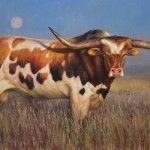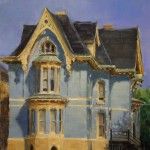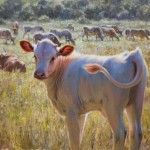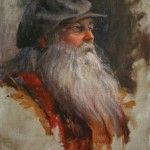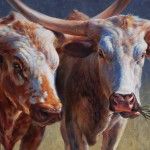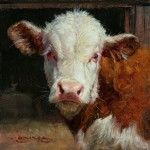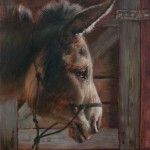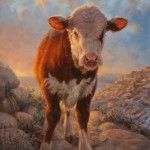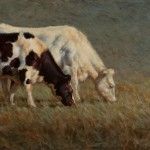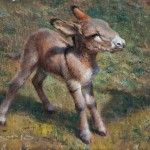William A. Suys Jr. is on a quest to capture the essence of life on canvas
By Norman Kolpas
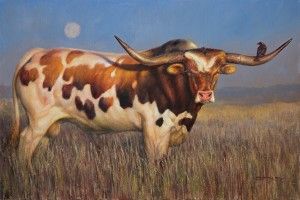
William Suys, Cowbird Moon, oil, 20 x 30.
This story was featured in the December 2015 issue of Southwest Art magazine. Get the Southwest Art December 2015 print issue or digital download now–then subscribe to Southwest Art and never miss another story
The distinguished gentleman regards you with a piercing gaze as a full moon rises in the distance. A touch suspicious, yet resolute, he stands solidly in his element, every impeccably rendered detail of his bearing bespeaking the fact that he’s a wise leader, a fierce defender of all who rely upon him. You feel you know him, understand him, as he stares at you from beneath his heavy-lidded eyes. And, perfectly captured in this portrait, he remains unfazed—even as an insouciant bird perches, almost disrespectfully, on one of his horns.
Yes, COWBIRD MOON, a recent oil by William A. Suys Jr., portrays not a human but a longhorn steer, standing in the open air amidst the tall grasses. But just the same, it is undeniably a portrait, as much as any boardroom or parlor image of a human being might be.
Credit the uncannily lifelike image not to some psychological trick or to a questionable urge to anthropomorphize the earth’s creatures but rather to the clear, plainspoken attitude of a Wisconsin-based artist who often refers to his body of work as People and Other Animals. Says Suys (which rhymes with guys), “Whether I’m painting an animal or a person, I like to find those subtle differences or idiosyncrasies that speak of the individual.” Just as with human beings, he adds, “When you start looking, really looking, at animals, you begin to see the character in their eyes.”
Stretching back to his earliest memories, Suys has been looking—really looking—at the world around him and portraying what he sees. “I would draw on scrap paper or the backs of writing pads, using pencil and later pen,” he says. “At first, I drew helicopters or cars or motorcycles, all mechanical things, and then, while I was still in grade school, I started drawing animals and people.”
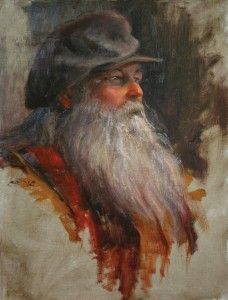
William Suys, The Storyteller, oil, 16 x 12.
Art may well have been in his blood. “I believe there was a relative in Belgium who was a well-known architect,” he notes, referring perhaps to Léon-Pierre Suys, the 19th-century designer of such monumental public buildings as the Brussels Stock Exchange, or maybe to Léon-Pierre’s father Tilman-François Suys, architect to the royal Belgian court earlier in that century.
But Suys more readily attributes his keenly attuned visual aesthetic to his own loving parents, both of whom were deaf. They fostered a deep love of all the arts, including music, in their son and two daughters. Suys muses that perhaps, “because sign language is a visual language, that might have had some effect” on his drive to create visual art. He also notes, somewhat wistfully, that an early love and talent he showed for playing musical instruments may have fallen by the wayside and been supplanted by art because “I would rather do something that they could appreciate.”
Regardless, Suys’ knack for and love of capturing realistic images found support from an unlikely source during high school. He hadn’t enrolled in any special art classes. “I drew for me,” he says. “And when I was supposed to be taking notes in school, I was always drawing in the margins of my notebooks.” One day, however, during German class in his sophomore year at a Catholic high school in Racine, WI, he was lost in his doodling when Sister Jane Weiss, the teacher, stopped next to him. “She put her finger on my drawing, and I thought she was going to scold me,” he remembers. “But she quietly said, ‘You keep that up.’ That really meant something to me, coming from someone who was a thoughtful person and really carried weight with me.”
After graduating, Suys first pursued studies at a school for commercial artists, but teachers there redirected him to fine-art studies. So he enrolled in the art departments at the University of Wisconsin at Stevens Point and then the University of Minnesota.
The free-spirited mid-1970s, however, were not an ideal time for an art student who had always been attracted to the works of the old masters and to classical realists of more recent eras, like John Singer Sargent or Andrew Wyeth. “Especially at Minnesota,” says Suys, “the teachers were basically saying things to us like, ‘Oh, be free!’ They didn’t teach us to build our craft. So I became less and less confident in art as a career, changed to a business and art major, and then finally got a business degree.”
That particular combination of studies led Suys to take a “dream job” in the commercial art department at Johnson Wax at its world headquarters in Racine. He stayed with the company for 20 years, progressing to management positions in sales and in the finance and credit department.
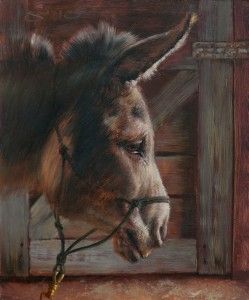
William Suys, Introspection, oil, 10 x 8.
Asked if that progression into more corporate responsibilities moved him away from the aesthetic pursuits he loved, Suys replies politely but emphatically to the contrary. “J-Wax was a company that really understood the value of art.” They’d hired none other than Frank Lloyd Wright to design the corporate headquarters building, which was completed in 1950, and filled the space with outstanding examples of art, believing that, says Suys, “Whether you’re developing a new product or process or procedure or a new line of business, you’re more likely to create something successful if you’re in a more creative environment. That gave me the feeling that there is a real value to art.”
His own natural drive to create thus bolstered, Suys never stopped painting in his spare time. “A lot of nights after work,” he continues, “I was at my drawing board at home until 4 in the morning, painting watercolors.” His landscapes, local scenes, and near-abstract images of the patterned Holstein cows so prevalent in Wisconsin sold well by word of mouth, without need for gallery representation or weekend art festivals.
As he closed in on two decades at Johnson in the late 1990s, Suys began to contemplate a full-time career as a fine artist and to turn his attention more and more to oils. “Intuitively, it made more sense to me to be painting with an opaque medium that enables me to create vision and depth and to express the way I really see and feel a subject, with so much opportunity to create beautiful visual effects and really powerful, heartfelt work,” he explains. He also knew, not insignificantly, that “all the valuable paintings that last for centuries are oils.”
His actual transition, beginning in 1998, happened fairly smoothly. Early on, he was commissioned to paint a posthumous portrait of S.C. Johnson, the founder in 1886 of his erstwhile employers. More commissions followed, and Suys’ second and third such works received Awards of Excellence from the Portrait Society of America. While he modestly concedes in retrospect that such recognition was “a big deal” for his career, he doesn’t look at those years as relying on milestones but rather as a steady progression. “Basically, I was always trying to develop the richness of my process and the results. I love to paint, and I want to meet my potential.”
That potential has certainly unfolded in some of his latest works. He’s particularly happy with SENATE BACKGROUND, a portrait of Scott McCallum, Wisconsin’s governor from 2001 to 2003, which was commissioned by private citizens, unveiled last June, and is now the property of the Wisconsin State Historical Society. Suys strove “to make a hero” of his subject, framing him against the skylit background of the state capitol’s rotunda. “I felt so thankful, and I wanted to put everything I have into this work,” he says of the richly detailed piece, which was met with the warmest approval by its subject.
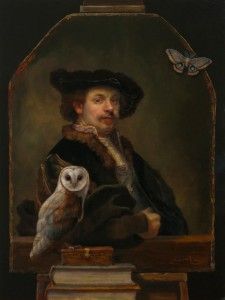
William Suys, Perceptions, oil, 24 x 18.
Based on such results, and continued demand for portraits, Suys could easily sit back and continue in that direction alone. But, just as he has since childhood, he continues to feel compelled to explore other subjects as well. Demand for his animal portraits is growing, leading him literally to roam farther afield to study cattle and other livestock firsthand, including a sojourn in Santa Fe with Kristin, his wife of eight years, this past October. He also continues to develop a series of works in which he juxtaposes scenes of famous works by the likes of Rembrandt and Renoir with images of the present-day people who’ve come to observe them. Add still-life paintings, landscapes, and plein-air pieces, and Suys remains ever more busy and engaged as he approaches his 60th birthday this December 29.
Prodigious though such an output may seem, Suys has a current goal, he says, of trying to “slow down and enjoy the process more. I’d rather produce 10 paintings that really speak to people than 50 that are pretty good. I want to develop every aspect of my work, the craft, the subject matter. Soulfulness is what I’m really trying to get to.”
In that regard, Suys remains ever optimistic. “I hope to venture further down my own path, where I continually build upon what makes me unique as an artist,” he concludes. “I will seek to intensify the power and presence of individuals, whether human, animal, or still-life subject; to build an ever-stronger connection between me and my work, which I believe will lead to a stronger connection between my work and the viewer; and to enhance the concept, craft, and resonance of the work I produce.”
representation
Trailside Galleries, Jackson, WY, and Scottsdale, AZ; Worrell Gallery, Santa Fe, NM; Marshall Gallery, Scottsdale, AZ; Edgewood Orchard Gallery, Fish Creek, WI; Dabbert Gallery, Sarasota, FL.
Featured in the December 2015 issue of Southwest Art magazine–click below to purchase:
Southwest Art December 2015 print issue or digital download Or subscribe to Southwest Art and never miss a story!
- William Suys, Cowbird Moon, oil, 20 x 30.
- William Suys, Juneau & Prospect, oil, 18 x 14.
- William Suys, Okies, oil, 16 x 20.
- William Suys, Senate Background: Governor Scott McCallum, oil, 44 x 32.
- William Suys, The Storyteller, oil, 16 x 12.
- William Suys, Buds, oil, 24 x 48.
- William Suys, Curious Calf, oil, 6 x 6.
- William Suys, Introspection, oil, 10 x 8.
- William Suys, Morning Calf, oil, 48 x 36.
- William Suys, Perceptions, oil, 24 x 18.
- William Suys, The Gloaming, oil, 12 x 24.
- William Suys, The Stand, oil, 8 x 10.
MORE RESOURCES FOR ART COLLECTORS & ENTHUSIASTS
• Subscribe to Southwest Art magazine
• Learn how to paint & how to draw with downloads, books, videos & more from North Light Shop
• Sign up for your Southwest Art email newsletter & download a FREE ebook






